赤狐Red fox
1. 分类Taxonomy
食肉目Carnivora
犬科 Canidae
狐属Vulpes
赤狐Vulpes vulpes(Linnaeus,1758);英文名Red Fox
2. 保护级别Conservation Assessment
l 我国国家二级重点保护动物物种
National second class key protected species of China
l IUCN红色名录低危物种
Least Concerned species on IUCN Red List
3. 形态特征Physical Description
赤狐是狐属中体型最大的动物,身体的长度有50-80厘米,尾巴长度为35-45厘米,体重3.6-7千克。
体型纤长,鼻子又细又长,耳朵比较大且形状尖尖。腿长而且细。尾巴很长,长度是身体长度的60%-70%。尾巴很粗,尾巴上的毛长而且蓬松(图1、2)。
赤狐身体上长着一层又长又粗的毛发,冬天它们身上毛发底层还有一层又厚又软的绒毛。在不同季节以及不同的地方,赤狐的毛发的形态和颜色差别很大,南方地区的赤狐毛薄而短,北方的赤狐毛长而浓密。整体的毛色可能是黄色,可能是褐色,也可能是深红色,但毛色一般为红褐色。腿黑色,肩膀和身体侧面更偏向淡黄色。耳朵后面为黑色或褐色;腹部白色。尾巴颜色与体色一样,尾巴尖是白色的(图1、2)。
尾巴上部有一个2厘米长的尾下腺,散发出狐臭味。
The red fox has the largest body size of Vulpes species. The length of their body is about 80 cm, the length of the tails is about 45 cm, and their weight is about 3.6-7 kg.
Red fox has slender body shape, a long snout, large triangle ears, as well as four long, thin legs. The tail is quite long, which is 60%-70% of the body length. The hair of tail is thick and long, which make it looks fluffy (Fig. 1, 2).
The fur is long and thick, and with thick, soft hair on the bottom in winter. Coloration and shape of fur varies depend on seasons and places. The fur is thinner and shorter in the south, while thicker and longer in the north. The overall hair color may be yellow, brown, or dark red, but usually reddish. The legs are black; the shoulders and the sides of body are pale yellow. The back side of the ear is black or brown, and belly is white. The color of the tail is like the color of the body, and the tail tip is usually white (Fig. 1, 2).
There is a 2cm grand under the tail, which makes red fox stink.
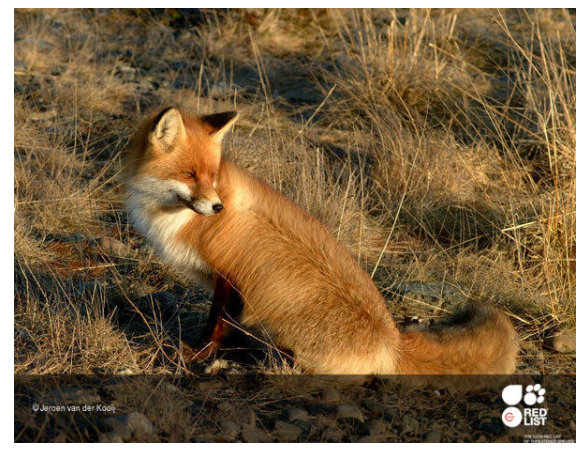
图1. 赤狐实体图(作者Jeroen van der Kooij;来源IUCN)
Figure 1. Red fox (contributor: Jeroen van der Kooij; origin: IUCN)
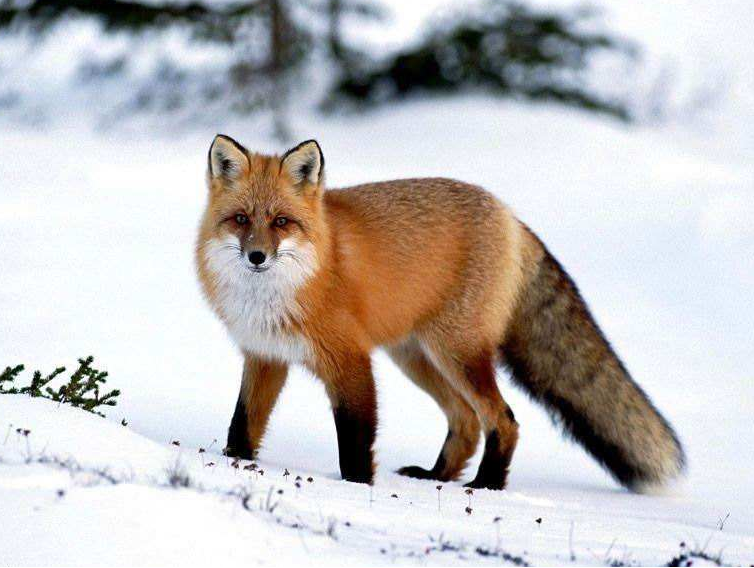
图2. 赤狐实体图(来源百度词条)
Figure 2. Red fox (origin: Baidu)
4. 地理分布
赤狐是全球分布范围最广的陆生食肉动物,遍布北半球欧亚大陆(除东南亚热带区)和北美洲大陆,并被人为引入至澳洲大陆等地(图3)。
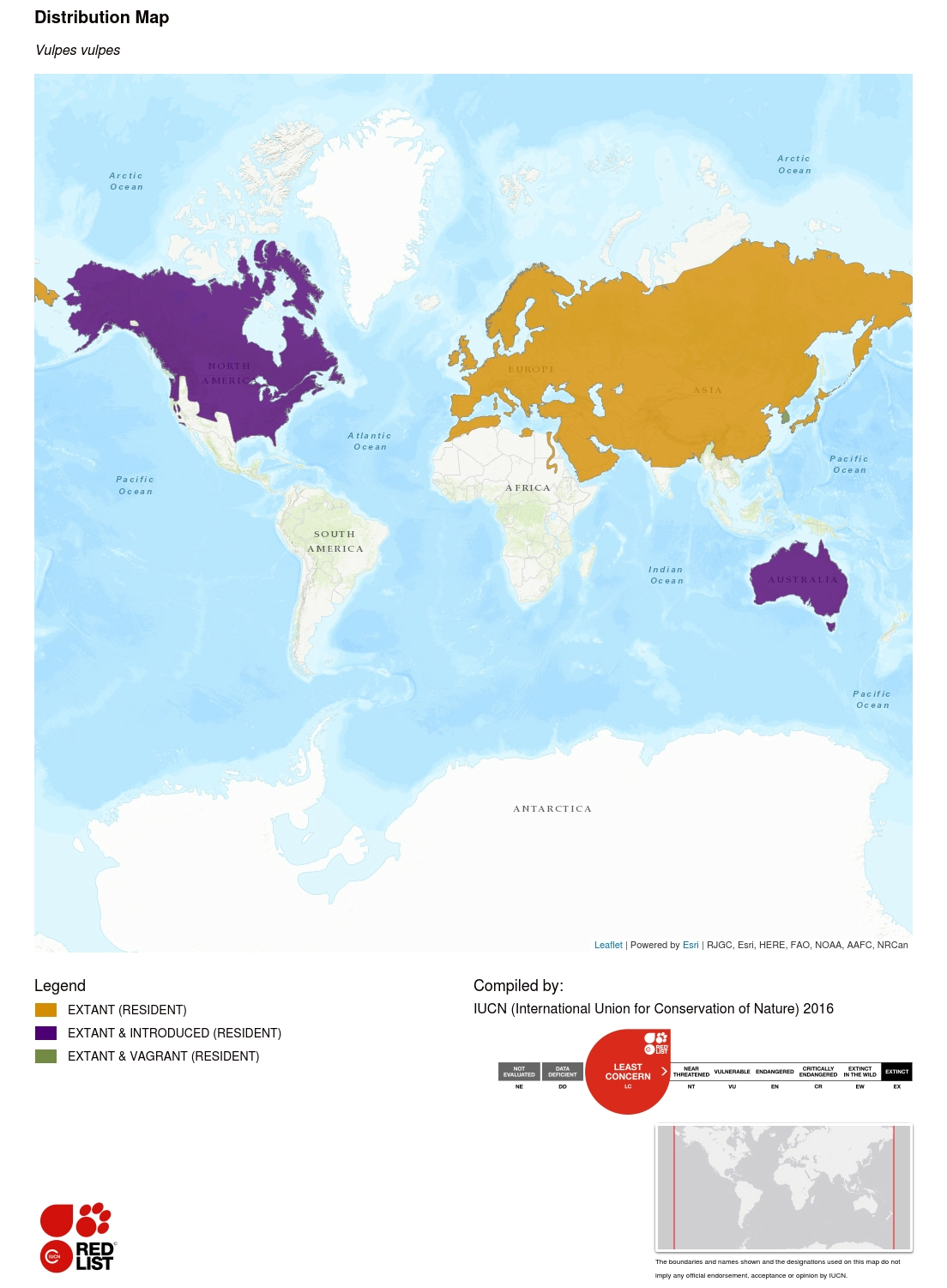
图3. 赤狐世界范围地理分布(来源IUCN)
Figure 3. Geographic range of red fox around the world (origin: IUCN)
在以前,我国除了台湾、海南以外,赤狐广泛分布在大陆各个省份,但现在的具体分布并不是很清楚,在华北山地(例如山西、河北)、青藏高原至横断山(例如西藏、青海、四川西部、云南西北部)、蒙古高原(例如内蒙古)和西北地区(例如新疆)仍较为常见。
Red foxes are the most widely distributed terrestrial carnivore in the world, whose range is throughout Eurasia (except tropical area of southeast Asia) and North America in the northern hemisphere, and were introduced into Australia and other places (Fig. 3).
When it comes to the range in China, in history, red foxes are widely distributed in the mainland except Taiwan, Hainan, but the specific distribution in present is not very clear. They are commonly seen in the mountain area of north China (e.g., Shanxi, Hebei), from the Tibet Plateau to the Hengduan Mountains (e.g., Tibet, Qinghai, western Sichuan, northwestern Yunnan), in Mongolia Plateau (Inner Mongolia), and northwest area of China (e.g., Xinjiang).
5. 栖息环境Habitat
赤狐可以生活在各种栖息地中,像荒漠、森林、高山苔原、农田和大都市城区等等。它们喜欢开阔的地方和有各种不同植物的灌木林中。
在北方地区它们会直接住在獾和旱獭这些动物的旧洞穴,或者把洞再挖大点再住进去。有时甚至能和獾住在同一个洞穴中。
Red foxes can live in a variety of habitats, such as deserts, forests, alpine tundra, farmland and metropolitan areas. They like open places and bushes with different kinds of plants.
In the north they might live directly in the old burrows of animals such as badgers and marmots, or enlarge the old burrows and move in. Sometimes they even live in the same burrow with badgers.
6. 生活习性Ecology
6.1 食物Food Habits
赤狐是肉食性动物,也就是主要是吃肉的。食物主要由小型地栖哺乳动物,像老鼠、兔子、松鼠组成;其它食物还有鸡类及其它鸟类、蛙类、蛇类、昆虫、浆果和植物。赤狐也可能吃腐肉,在冬季与早春,因为食物短缺,赤狐食腐的比例会增加。
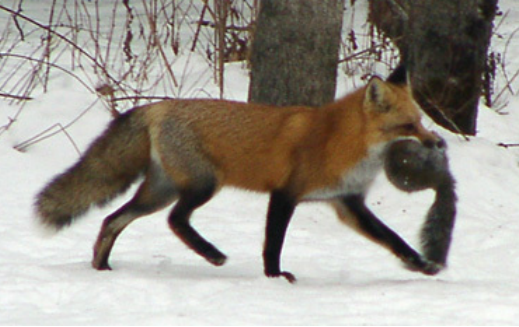
图4. 赤狐捕食(作者Jim Germond;来源Animal Diversity Web)
Figure 4. Red fox and its prey (contributor: Jim Germond; origin: Animal Diversity Web)
赤狐会贮存剩余的食物。
Red foxes are carnivores, meaning they eat mostly meat. Their diet consists mainly of small ground-dwelling mammals such as mice, rabbits, and squirrels; Other foods include chickens and other birds, frogs, snakes, insects, berries and plants. Red foxes may also eat carrion, which increases in winter and early spring when food is scarce.
Red fox will storage the food surpluse.
6.2 社群Sociality
通常为独居,但母狐携带幼崽活动的母子群也经常可见(图5)。
Red fox is usually solitary, but the mother-children groups are also common (Fig. 5).
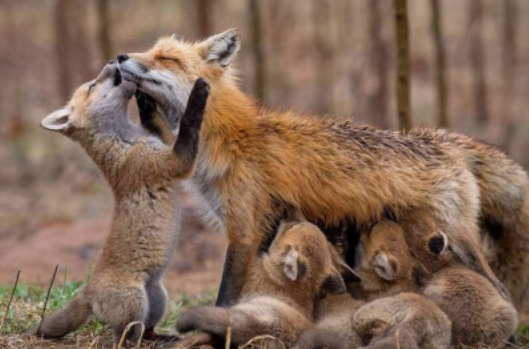
图5. 母赤狐与幼崽(来源堆糖网)
Figure 5. Mother-children family group (origin: www.duitang.com)
6.3 领域Home range
活动范围大,每天活动范围达10 平方千米,领地不重叠。冬季领域比夏季的大。秋季进行扩散,雄性通常比雌性扩散得更远。
The activity range of red fox is large, with the daily range up to 10 km2. Their territory does not overlap. The territory range in winter is larger than that in summer. Red foxes spread in autumn, males usually spread further than females.
6.4 节律Rhythm
夜行性动物,喜欢在夜间活动。
Red foxes are nocturnal animals who tend to be active at night.
7. 繁殖
赤狐一般为一夫一妻制。
雌性发情期持续1-6天。雄性在繁殖季节会进行争斗。
交配季节从12月底到3月底,一次交配持续15-20分钟,交配过程中个体会发出叫声。
妊娠期49-56天,一般为51-53天。3-5月幼崽出生;赤狐常常挖洞产仔育幼。每胎产仔 1-13只,均值为5只。新生儿体重为50-150克;出生时眼没睁开,到9-14天后才会睁眼。幼崽约4-5周后会离开巢穴,哺乳期持续约45天,10月龄时性成熟。
双亲共同照顾幼崽,公狐也会参与育幼。
赤狐在圈养环境中寿命能达到10-12年。
Red foxes are generally monogamous.
The annual estrous period of female red foxes last from 1 to 6 days. Males fight during the breeding season.
The mating season is from the end of December to the end of March. Copulation usually lasts 15 or 20 minutes and is often accompanied by a vocal clamor.
Gestation is typically between 51 and 53 days but can be as short as 49 days or as long as 56 days. Litters vary in size from 1 to 13 pups with an average of 5. Birth weight is between 50 and 150 g. The pups are born blind but open their eyes 9 to 14 days after birth. Pups leave the den 4 or 5 weeks after birth and are fully weaned by 45 days. Sexual maturity is reached by 10 months.
Both parents share the care of the young, and the male fox also participates in the rearing.
Red foxes can live for 10-12 years in captivity.
参考文献Reference
FOX D. "Vulpes vulpes" (On-line), Animal Diversity Web[EB/OL]. 2007. https://animaldiversity.org/accounts/Vulpes_vulpes/
HOFFMANN M, SILLERO-ZUBIRI C. Vulpes vulpes (amended version of 2016 assessment). The IUCN Red List of Threatened Species 2021: e.T23062A193903628[EB/OL]. 2021. https://dx.doi.org/10.2305/IUCN.UK.2021-1.RLTS.T23062A193903628.en
SMITH A T, 解焱. 中国兽类野外手册[M]. 长沙: 湖南教育出版社, 2009.
国家林业和草原局/国家公园管理局. 国家重点保护野生动物名录[EB/OL]. 2021. http://www.forestry.gov.cn/html/main/main3954/20210225160347342521589/file/20210225160401102702964.pdf
刘少英, 吴毅. 中国兽类图鉴[M]. 福州: 海峡书局, 2019.
鲁长虎, 孙立峰. 南京市野生动物资源[M]. 南京: 东南大学出版社, 2016.